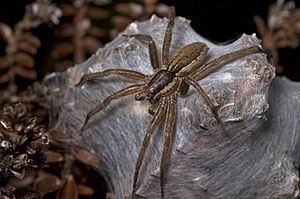Dolomedes minor facts for kids
Quick facts for kids Dolomedes minor |
|
|---|---|
 |
|
| Female guarding nursery web | |
| Scientific classification |
The Dolomedes minor is a special spider found only in New Zealand. It's often called the nursery web spider because of the unique way it cares for its babies. This spider belongs to a family called Pisauridae.
What Does It Look Like?
The nursery web spider is usually a pale brown color, sometimes a bit grayish. This helps it blend in with rocks and plants, hiding it from animals that might want to eat it.
This spider has some interesting body parts:
- Pedipalps: These are like small feelers near its mouth. They help the spider sense things around it. Male spiders use their pedipalps to help with reproduction.
- Chelicerae: These are its jaws, located right below its eyes. They are quite large!
Female nursery web spiders are almost twice as big as males. A full-grown female can have a leg-span of over sixty millimeters, which is more than two inches! These spiders can also move very quickly.
Where Does It Live?
You can find the Dolomedes minor spider all over New Zealand. It lives in many different places, from areas near the sea all the way up to high mountain regions.
It likes various habitats, including:
- Shrublands, where plants like Gorse and Manuka grow.
- Swamps.
- Grasslands.
When it's hunting, you might spot it near the edge of water or among stones. These spiders are active at night. You can often see their large, white nursery nests, which are thickly woven onto the ends of plants in these areas. Female spiders usually stay with their young in these nests.
Life Cycle
You're most likely to see Dolomedes minor spiders during the summer months, from November to May. During this time, female spiders carry their egg-sacs with them, holding them in their fangs for at least five weeks!
After carrying the eggs, the female spider builds a special "nursery web." This web isn't for catching food; it's a safe place for her young. She builds it at night, usually among the tips of plants. These nests can be six inches or more in length and will protect the eggs and young spiderlings. The female guards the web at night, and during the day, she often moves closer to the base of the plants.
The baby spiders, called spiderlings, usually come out of the eggs within a week of the web being built. Most of them leave the nest after about two weeks. They often leave by "ballooning," which means they release long strands of silk into the air. The wind then carries them away, helping them travel to new places.
Hunting and Food
The Dolomedes minor spider hunts and looks for food at night. It eats many small creatures, including:
- Locusts
- Other spiders
- Dobson fly larvae
- Earthworms
- Bees
- Other small insects
Even though it's a good hunter, it will also eat animals that are already dead. This spider doesn't use its web to catch prey. Instead, it hunts by waiting for food to come close. It relies on touch and chemical senses to find prey, not its eyesight. Tiny hairs on its body help it feel and capture food.
Nursery web spiders eat their food very quickly when they find it. They have even been seen catching more prey while still eating! This quick eating helps them get enough food because there aren't as many insects active at night.


